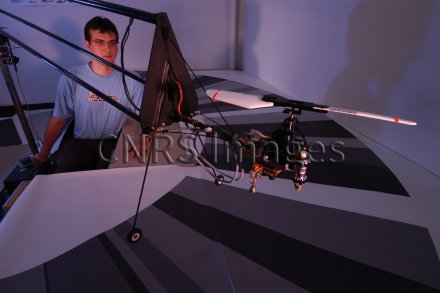Production year
2005

© Hubert RAGUET / CNRS Images
20050001_1089
OCTAVE est un hélicoptère captif de 100 grammes doté de vision. Son oeil ventral observe le relief survolé à 3m/s et mesure le flux optique de translation grâce à un neurone détecteur de mouvement (0,8 g) dérivé de la mouche. Il est doté d'un pilote automatique appelé "régulateur de flux optique", qui lui permet de réaliser des prouesses telles qu'un décollage automatique, un suivi de terrain automatique, un atterrissage automatique, ainsi qu'une réaction sensée au vent sans faire appel aux capteurs avioniques traditionnels. Installé sur un engin aérien, spatial ou sur un sous-marin benthique, il pourrait fonctionner aussi pour le pilotage automatique sans visibilité.
The use of media visible on the CNRS Images Platform can be granted on request. Any reproduction or representation is forbidden without prior authorization from CNRS Images (except for resources under Creative Commons license).
No modification of an image may be made without the prior consent of CNRS Images.
No use of an image for advertising purposes or distribution to a third party may be made without the prior agreement of CNRS Images.
For more information, please consult our general conditions
2005
Our work is guided by the way scientists question the world around them and we translate their research into images to help people to understand the world better and to awaken their curiosity and wonderment.